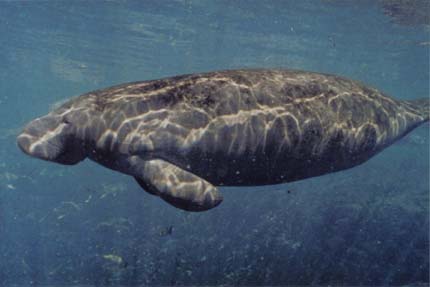The Manatee
West Indian Manatee Facts
Description: West Indian manatees are large, gray aquatic mammals with bodies that taper to a flat, paddle-shaped tail. They have two forelimbs, called flippers, with three to four nails. Their head and face are wrinkled with whiskers on the snout. The manatee's closest land relatives are the elephant and the hyrax, a small, gopher-sized mammal. Manatees are believed to have evolved from a wading, plant-eating animal. The West Indian manatee is related to the West African manatee, the Amazonian manatee, the dugong, and to the Steller's sea cow, which was hunted to extinction in 1768. The average adult manatee is about three meters (9.8 feet) long and weighs between 362-544 kilograms (800-1,200 pounds).
Habitat and Range: Manatees can be found in
shallow, slow-moving rivers, estuaries, saltwater bays, canals and coastal areas. Manatees
are a migratory species. Within the United States, West Indian manatees are concentrated
in Florida in the winter, but they can be found in summer months as far west as Texas and
as far north as Virginia. However, these sightings are rare. Summer sightings in Alabama,
Georgia and South Carolina are common. West Indian manatees can also be found in the
coastal and inland waterways of Central America and along the northern coast of South
America, although distribution in these areas may be spotty.
Behavior: Manatees are gentle and
slow-moving. Most of their time is spent eating, resting, and in travel. Manatees are
completely herbivorous. They eat aquatic plants and can consume 10-15% of their body
weight daily in vegetation. They graze for food along water bottoms and on the surface.
They may rest submerged at the bottom or just below the surface, coming up to breathe on
the average of every three to five minutes. When manatees are using a great deal of
energy, they may surface to breathe as often as every 30 seconds. When resting, manatees
have been known to stay submerged for up to 20 minutes.
Lifespan, Mortality, Population: West Indian
manatees have no natural enemies, and it is believed they can live 60 years or more. Many
manatee mortalities are human-related. Most human-related manatee mortalities occur from
collisions with watercraft. Other causes of human-related manatee mortalities include
being crushed and/or drowned in canal locks and flood control structures; ingestion of
fish hooks, litter and monofilament line; entanglement in crab trap lines; and vandalism.
Ultimately, however, loss of habitat is the most serious threat facing manatees today.
There are approximately 3,000 West Indian manatees left in the United States.
Breeding and Reproduction: The reproductive rate for manatees is slow. Female manatees are not sexually mature until about five years of age, and males are mature at approximately nine years of age. On average, one calf is born every two to five years, and twins are rare. The gestation period is about a year. Mothers nurse their young for one to two years, so a calf may remain dependent on its mother during that time.
Legal Protection: West Indian manatees in the United States are protected under federal law by the Marine Mammal Protection Act of 1972 and the Endangered Species Act of 1973, which make it illegal to harass, hunt, capture, or kill any marine mammal. West Indian manatees are also protected by the Florida Manatee Sanctuary Act of 1978 which states: "It is unlawful for any person, at any time, intentionally or negligently, to annoy, molest, harass, or disturb any manatee." Anyone convicted of violating Florida's state law faces a possible maximum fine of $500 and/or imprisonment for up to 60 days. Conviction on the federal level is punishable by a fine of up to $100,000 and/or one year in prison.
Conservation: The Florida Manatee
Recovery Plan was developed as a result of the Endangered Species Act. The recovery plan is coordinated by the U.S. Fish & Wildlife Service (USFWS) and sets forth a list of tasks geared toward recovering manatees from their current endangered status. Save the Manatee Club is part of the Manatee Recovery Team, which carries out the tasks in the plan under the auspices of the USFWS. In addition, SMC is part of the Manatee Technical Advisory Council, which makes recommendations to government officials on manatee protection issues.
In October of 1989, Florida's Governor and Cabinet directed the Florida Department of Environmental Protection to work with 13 "key" manatee counties in Florida to reduce injuries and deaths. These 13 counties include: Duval, Volusia , Citrus, Brevard, Indian River, St. Lucie, Martin, Palm Beach, Broward, Dade, Collier, Lee and Sarasota. Over 80% of manatee mortalities have occurred in these counties. The first task of these 13 county governments, working with the state, is to develop site specific boat speed zones to reduce watercraft collisions. The second task is to develop comprehensive manatee protection plans (MPP) at the local level. Twelve of the 13 key counties have implemented boat speed zones for manatee protection. Several key counties are currently at work on their MPPs.
Other conservation measures deemed important to saving
manatees include: research covering the biology, mortality, population and distribution,
behavior, and habitat of manatees; implementation of management plans; posting of
regulatory speed signs and levying of fines for excess speeds in designated areas; manatee
education and public awareness programs; and public acquisition of critical habitat and
creation of sanctuaries.
Information from SaveTheManatee.org.
My adopted manatee from Homosassa Springs State Wildlife Park, Rosie.

Image Courtesy: Save The Manatee Club.

